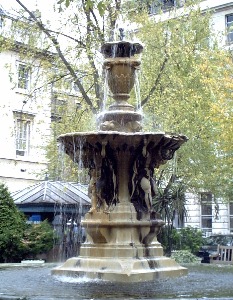
A City Gardens Walk
Route & what to see
|
|
| london-footprints.co.uk |
A 3 mile walk linking some of the gardens maintained by the City of London. A number were formerly churchyards. It begins at Cannon Street Station and finishes at Liverpool Street Station.
Exit station into Cannon
Street and go left along Dowgate Hill then right at College
Street.
The WHITTINGTON GARDENS are named after Dick Whittington,
associated with the church opposite. The sculptures of horsemen
by Cambellotti were a gift from the Italian President in 2005.
Continue along Skinners Lane
to the end then right at Little Trinity Lane. Go through Huggin
Court to the left.
The CLEARY GARDEN is named after Fred Cleary (see plaque). It was
originally created by a shoemaker from Walthamstow on the site of
a Blitzed house. The Japanese Tree Peonies were gifted in 2006.
The garden was improved by Loire Valley Wines in conjunction with
Open Squares Weekend.
Cross Queen Victoria Street
and go along Friday Street. Left along Cannon Street then St
Paul's Churchyard.
CARTER LANE GARDEN
Cross towards the cathedral
then go right.
The FESTIVAL GARDENS were created for the Festival of
Britain in 1951 by Sir Albert Richardson. They feature a hedge of
pleached limes.
Cross New Change
25 CANNON STREET is an award winning public space designed
in 2000 by Elizabeth Banks Associates.
Return between the Festival
Garden and church tower.
ST PAUL'S CATHEDRAL CHURCHYARD GARDEN was laid out in 1879
by Edward Milner. There are a number of notable trees including
variegated Tulip Tree, Walnuts, Weeping Mulberry, Weeping Pear,
Persian Ironwood, Ginkgos and Katsura Tree. The rose garden was
planted in 1976.
Exit into New Change and go
anticlockwise around St Paul's tube station. Cross and go left
along Newgate Street.
The structure on the traffic island has been planted with
climbing plants. The CHRISTCHURCH & GREYFRIARS GARDEN
reflects the former Wren church. This was destroyed by bombing in
1940 except for the tower.
Continue along Newgate
Street and cross at the junction.
The public space opposite the OLD BAILEY is one of the
City's newer gardens.
Cross to the church
ST SEPULCHRE
Go along Giltspur Street
then clockwise around West Smithfield.
In addition to being a livestock market WEST SMITHFIELD was
the site of meetings, tournaments and executions. The garden is
sited above a car park with a circular access ramp, previously
used by horse drawn carts serving the market.
Enter St Bartholomew's
Hospital at the main gate and walk through to the central
courtyard.
ST BARTHOLOMEW'S
Follow exit signs to
Bartholomew Close. Follow this road round into Little Britain
then cross King Edward Street.
The churchyards of St Botolph and other churches were laid
out as a public park in 1880. It became known as POSTMANS PARK
when used by workers from the neighbouring Post Office. It is
noted for its memorials commemorating heroic deeds of ordinary
people, created by GF Watts. There is a Handkerchief Tree in the
garden and a pond with fish.
Right at Aldersgate Street
then left into Gresham Street
The garden surrounding ST ANNE & ST AGNES CHURCH was
created in the 1970s. Trees include Indian Bean, false acacia,
rowan and cherry.
Left along Noble Street
The NOBLE STREET GARDENS contain remains of the Roman Wall
and have been planted with wild flowers.
The church of ST OLAVE SILVER STREET was destroyed in the Great
Fire. The site features Robina and oak trees.
Return and go left at Oat
Lane
ST MARY STAINING
Go along Staining Lane and
pass in front of the Lloyds TSB building
The ST JOHN ZACHARY GARDEN occupies the site of a church,
partly destroyed in the Great Fire. A prize winning garden was
created on the bomb damaged site in the 1940s. The current garden
was laid out in 1995 and is maintained by the Goldsmiths' Company
who have their hall opposite.
Continue along Gresham
Street
ST LAWRENCE JEWRY water garden
Go along Aldermanbury
The ST MARY ALDERMANBURY GARDEN includes the footings of the
1437 church, damaged by bombing and reconstructed in America (see
plaque). It adjoins the stables for the City of London police
horses. The corner section has a bust of Shakespeare, which
actually commemorates Hemynge and Condell, responsible for the
printing of the first folio. There is a water garden on the other
side of Aldermanbury.
Continue to Aldermanbury
Square.
ALDERMANBURY SQUARE was created in 1962 but re-landscaped
for the millennium. A bench is inscribed with a history of the
site.
Go through the passage
towards London Wall
BREWERS' HALL GARDEN features a sculpture 'The Gardener'.
Return and go along
Basinghall Avenue
The private GIRDLERS' HALL GARDEN has attractive shrubs and
a mulberry tree.
Left at Coleman Street then
cross into Moorgate. First right into Finsbury Circus.
FINSBURY CIRCUS GARDEN is Grade II listed and the largest
garden in the City. It was designed by Charles Dance the Younger
in 1815 on the site of a recreational ground. It has been home to
the City of London Bowling Club since 1925. There are a number of
old Plane trees and a Japanese Pagoda Tree.
Exit at the far side and go
right along Blomfield Street then left at London Wall.
ALL HALLOWS LONDON WALL
Left at Old Broad Street
then right through Bishopsgate Churchyard.
The former churchyard of ST BOTOLPH WITHOUT BISHOPSGATE
along with a section of land donated in 1760 forms the present
garden. There are facilities for netball.
Left along Bishopsgate to Liverpool Street Station.
london-footprints.co.uk 2012
Resources
City of London Gardens webpage
The London Parks & Gardens Trust has a City Gardens walk [webpage].
Details of all the gardens featured plus others can be found on
the LPGT Gardens Online website.